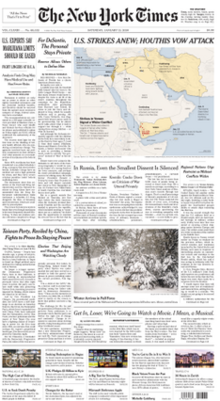How News Articles can Save You Time, Stress, and Money.
Wiki Article
Rumored Buzz on News Articles
Table of ContentsUnknown Facts About News ArticlesThe Facts About News Articles RevealedThe 3-Minute Rule for News ArticlesRumored Buzz on News ArticlesSome Known Details About News Articles
Great understanding of various subjects provides trainees a competitive side over their peers. Even though digital and social media sites are easily available, we need to not fail to remember just how crucial it is to read the papers. Parents should try and inculcate the habit of checking out a paper as an everyday regimen to continue the tradition of the adored print tool.Information stories also consist of at the very least one of the adhering to essential characteristics family member to the intended audience: proximity, prestige, timeliness, human passion, strangeness, or consequence.
Within these restrictions, information stories likewise aim to be detailed. Among the larger and much more respected papers, justness and balance is a major element in presenting information.
Papers with a worldwide audience, for instance, have a tendency to use a more official style of writing. News Articles.; typical style guides include the and the United States Information Design Publication.
An Unbiased View of News Articles
As a rule, journalists will not use a lengthy word when a brief one will do. News writers attempt to prevent making use of the very same word a lot more than as soon as in a paragraph (often called an "echo" or "word mirror").
However, headlines occasionally leave out the topic (e.g., "Jumps From Boat, Catches in Wheel") or verb (e.g., "Pet cat female lucky"). A subhead (also subhed, sub-headline, subheading, caption, deck or dek) can be either a subservient title under the primary headline, or the heading of a subsection of the post. It is a heading that precedes the major text, or a team of paragraphs of the major text.
Added billboards of any of these types might show up later in the post (particularly on succeeding web pages) to lure more reading. Such billboards are also used as reminders to the short article in other sections of the magazine or website, or as promotions for the piece in various other publication or websites. Typical structure with title, lead paragraph (summary in vibrant), various other paragraphs (details) and call information.

Instance of a hard-lead paragraph NASA is proposing one more space task. The agency's spending plan request, introduced today, included a plan to send an additional objective to the Moon. This time the company wants to establish a lasting center as a jumping-off place for other area experiences. The budget demands about $10 billion for the job.
The NASA statement came as the agency requested $10 billion of appropriations for the project. An "off-lead" is the second most vital front page information of the official website day. The off-lead appears either in the leading left edge, or directly listed below the Source lead on the. To "hide the lead" is to begin the article with history details or details of additional relevance to the readers, requiring them to check out even more deeply into a short article than they need to need to in order to uncover the essential points.
Getting My News Articles To Work
Common usage is that or 2 sentences each form their very own paragraph. Journalists typically explain the company or framework of a newspaper article as an upside down pyramid. The necessary and most interesting elements of a story are placed at the start, with supporting information complying with in order of lessening value.It allows people to explore a topic to only the depth that their inquisitiveness takes them, and without the imposition of information or nuances that they might think about unimportant, yet still making that details offered to extra interested viewers. The upside down pyramid framework additionally allows posts to be cut to any kind of approximate length during design, to suit the area offered.
Some writers start their stories with the "1-2-3 lead", yet there are numerous kinds of lead available. This format usually begins with a "5 Ws" opening paragraph (as explained above), adhered to by an indirect quote official source that offers to sustain a major element of the first paragraph, and after that a direct quote to sustain the indirect quote. [] A twist can refer to multiple things: The last tale in the information program; a "pleased" story to end the show.
Longer write-ups, such as publication cover articles and the pieces that lead the inside areas of a newspaper, are recognized as. Function stories vary from straight news in numerous ways.
An Unbiased View of News Articles
The journalist typically information interactions with interview topics, making the piece a lot more individual. A feature's very first paragraphs frequently connect a fascinating minute or event, as in an "anecdotal lead". From the details of a person or episode, its view rapidly widens to generalities about the tale's topic. The area that signifies what a feature has to do with is called the or signboard.
The Editor's Toolbox: A Reference Overview for Beginners and Professionals (2001) Allan M. Siegal and William G. Connolly. The New York Times Handbook of Style and Use: The Official Design Overview Utilized by the Writers and Editors of the World's Most Reliable Newspaper (2002) M. L. Stein, Susan Paterno, and R.
Report this wiki page